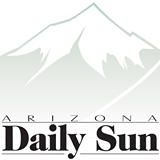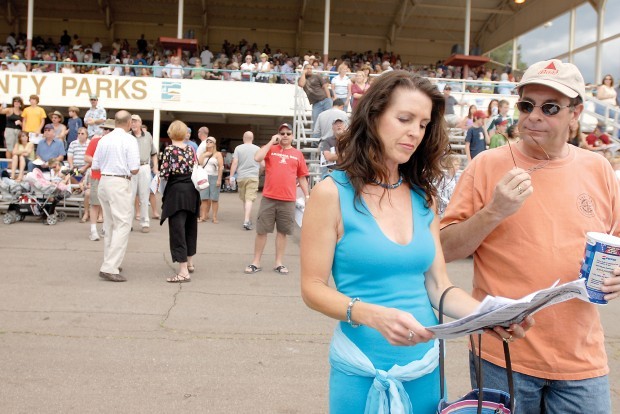 Sunday, July 06, 2008
Sunday, July 06, 2008
Special Reporter
In the movie “Seabiscuit: An American Legend,” jockey John “Red” Pollard is asked to breeze a horse.
What on Earth is that, I wondered? I soon found out that breezing means to let a horse run easily with little encouragement — in Red’s case, it could nearly kill a guy.
After that, I wanted to see a real race.
There is nothing like hands-on experience, so my brother-in-law, Kevin, and I headed out to Coconino County’s 53rd Annual Horse Races at Fort Tuthill Saturday. More than 15,000 people attend the event from July 4-7, which boasts the only live horse racing in Arizona on Independence Day weekend. Monday is Family Fun Day, with free admission and activities for kids.
Kevin and I arrived early to familiarize ourselves with the horses and make our picks for the first three races. We bought a Racing Program — it’s more chicken scratch than a newbie needs, but it lists the day’s sponsored races plus key racing history on each horse.
Each page contains a numbered race and distance, plus the horses running in it. Suggested winners are listed in the corner under boxes for marking one’s choices to win, place and show. We banked on the tried-and-true adage, “Winners keep on winning, losers keep on losing,” and selected our favorites for the Third Race.
Kevin and I gave marginal attention to statistics and slightly more to horses with appealing names. We worked backward from there.
Next, we graduated to considering a Trifecta wager in the Second Race. For $12, we picked a winning horse and three others, of which two need to be winners. Proud of himself, Kevin left to buy lemonade.
I eyed a man at our table who looked to be engaging data and logic to choose winners. His upright posture and tally of numbers on a legal pad looked like code, so I was sure it was important. I introduced myself and asked his advice.
“Have a set amount of money you’re willing to spend,” said Dave, “and then, look for a happy horse. That’s a good sign, but just have fun.”
“OK, but who should I bet on in the first race?” I pressed him.
“These are maidens — babies — and they’ll bump coming out of the chute. Bet on No. 3,” he said. So, I braved it and bet a thick’un — a big bet — for me, anyway.
A tractor with an American flag mounted on top stopped grading the track, and we stood for the broadcasted National Anthem. The first race was a mess of horses as Dave said it would be, but I won $18. Kevin lost.
In the Second Race, our Trifecta chances vanished with a photo finish. Nonplused, Kevin and I headed to the paddock before the Third Race to see if our horse picks looked happy. Some were skittish, but his was sedate. “Quiet confidence,” Kevin mused as we shared a beer.
I wagered Bobby Good News “on the nose” because I loved the name. In the 300-yard sprint, Kevin’s Quick Payback — chosen for the same reason — came in last. I netted nearly $6. You’re good news indeed, Bobby.
Losing is easy — ask Kevin — but how did my payouts add up? Simply multiply the odds and the bet amount for your total. Or simpler still, consult the Probable Payoff Box in the Race Program.
Our day was full of laughter, cheers and gorgeous animals. Somewhere between the burgers, beer and Cliff Castle Casino’s Plinko game — someone won barbecue tools! — Kevin said, “There aren’t enough o’s in how cool this was. I’ll be back.”
And me? You already know: I’m in the money.
Glossary
Daily Double — wager picks winners of two consecutive races
Furlong — 1/8 mile; 8 furlongs equals a mile.
Handicap –a selection made on the basis of past performance
In the Money — a win, place or show with a mutuel pay-off
Odds — fraction by which a win is paid
On the Nose — bet on horse to win only
Pari-mutuel — wagering system with total distributed to winning ticket holders less percent for track management, state tax and racing industry
Quinella — wager where first 2 finishers picked in either order
Trifecta — wager picking the finishing 3 horses in exact order

